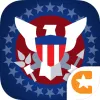Take a look inside 7 images
Executive Command
Pros: Gives students a solid grounding in what the president does.
Cons: Sometimes feels like a race against the clock.
Bottom Line: This game can be a good way to introduce some aspects of the presidency and the executive branch to students even though it lacks some political complexity.
Executive Command is a good simulation to explore in a civics or social studies class. Teachers can begin by tackling the Extension Pack on the website, asking the class pre-game discussion questions, having students play the game, and then finishing with the post-game discussion questions. Have students read through the in-game Game Guide as soon as they begin, as it will orient players to the available buildings and the responsibilities that they, as president, will be expected to take on.
Alongside the game, add in the lesson (available on the website) that supports the game's content by addressing what the president's actual duties are, how presidents get their powers from the Constitution, and all about the executive branch's domestic and foreign affairs. The game can have a greater impact when also put into a context of economic, political, and moral compromises that are required when running the country.
Once students master the game at Normal speed, they can try Fast speed, where they will really have to think on their feet.
Executive Command is a simulation game in the iCivics series (available on the web as well as iOS and Android) that puts students in the role of president. During their four-year term, students champion their chosen political issues while dealing with bills, diplomacy, and war. After picking an avatar, students decide on an agenda. Most of the gameplay then focuses on examining bills to sign or veto, delivering signed bills to the correct cabinet department, and gaining the support of Congress by giving speeches. Students must also take diplomatic action, either traveling to foreign lands themselves or sending their Secretary of State. During their term, they'll also go to war. If they handle this well -- deploying the correct types of troops at the correct times - they'll gain even more popular support.
The game's action takes place on a stylized map of Washington, D.C., featuring the White House, several cabinet-level departments, the Capitol, Air Force One's hangar, and the Pentagon. A few times per "year," players address Congress to drum up support for their chosen agenda. If Congress gives the president its support, it sends several bills on the president's agenda to the White House during the last "year" in office. The rest of the game focuses on signing or vetoing bills, delivering laws to appropriate agencies, accepting or declining diplomatic invitations, and waging war.
The game is timed. The four-year-term clock ticks down as students travel from building to building, but it pauses while they're inside buildings or studying bills. The game has recently been updated, and its refreshed look is more appealing. Students with iCivics accounts can save games in progress, earn achievements, and earn points to vote for civic participation projects on iCivics.com.
Full Disclosure: iCivics and Common Sense Education share a funder; however, that relationship does not impact Common Sense Education's editorial independence and this learning rating.
Executive Command is an effective and engaging introduction to the executive branch that gives students a solid overview of the presidency. However, it sacrifices some of the complexity of governing in an effort to remain politically neutral. Decisions players make can have some obvious right or wrong answers. For example, when addressing Congress about education, the player might need to choose between saying something cogent, or "I don't really care what happens to our education system." There's a missed opportunity here to have kids think critically, or to see how politicians must shape messages. Students do practice their evaluation and critical thinking skills, however, when examining and delivering bills. They must evaluate each line item, deciding which are good ideas and which are probably bad ideas (like getting rid of schools altogether). If any are bad ideas, students must veto the bill. If students sign the bill, they then must carry it to the proper department so it can be executed.
Executive Command effectively teaches a basic, foundational understanding of the presidency, its roles, and its responsibilities in federal government. Though some of the answers are obviously the correct ones, the speed element adds practice in thinking quickly and correctly on your feet, and balancing your own agenda with that of the country as a whole. Figuring out what best serves one's own agenda and what addresses the nation's safety and well-being promotes critical thinking and decision-making skills.















